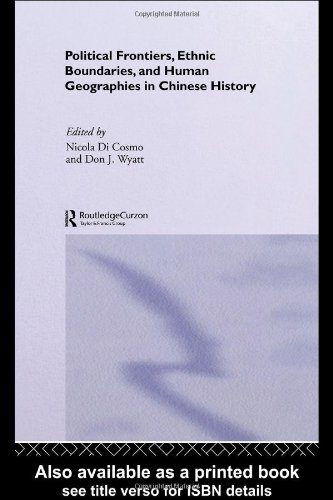

Most ebook files are in PDF format, so you can easily read them using various software such as Foxit Reader or directly on the Google Chrome browser.
Some ebook files are released by publishers in other formats such as .awz, .mobi, .epub, .fb2, etc. You may need to install specific software to read these formats on mobile/PC, such as Calibre.
Please read the tutorial at this link. https://ebooknice.com/page/post?id=faq
We offer FREE conversion to the popular formats you request; however, this may take some time. Therefore, right after payment, please email us, and we will try to provide the service as quickly as possible.
For some exceptional file formats or broken links (if any), please refrain from opening any disputes. Instead, email us first, and we will try to assist within a maximum of 6 hours.
EbookNice Team

Status:
Available0.0
0 reviews
ISBN 10: 0203987950
ISBN 13: 9780203987957
Author: Nicola Di Cosmo, Don J Wyatt
Boundaries - demanding physical space, enclosing political entities, and distinguishing social or ethnic groups - constitute an essential aspect of historical investigation. It is especially with regard to disciplinary pluralism and historical breadth that this book most clearly departs and distinguishes itself from other works on Chinese boundaries and ethnicity. In addition to history, the disciplines represented in this book include anthropology (particularly ethnography), religion, art history, and literary studies. Each of the authors focuses on a distinct period, beginning with the Zhou dynasty (c. 1100 BCE) and ending with the early centuries after the Manchu conquest (c. CE 1800) - resulting in a chronological sweep of nearly three millennia.
1. Toward a Social Geography of the Zhouyuan During the Western Zhou Dynasty: The Jing and Zhong Lineages of Fufeng County
Discerning Families and Lineages from Vessels Made By and for Women
The Jing Lineage
The Zhong Lineage
Concluding Remarks
Notes
Bibliography
Glossary
2. Mapping a “Spiritual” Landscape: Representation of Terrestrial Space In the Shanhaijing
Form and Content of the Shanhaijing (General Characteristics)
Working Out Methodological Perspectives
Perspectives of the Proposed Study
Terrestrial Space As a System of Itineraries
A Landscape Determined By Spirits
Conclusions
Hypotheses for Further Exploration
Notes and Abbreviations
Bibliography
Glossary
3. Ethnicity and Identity: Northern Nomads As Buddhist Art Patrons During the Period of Northern and Southern Dynasties
Introduction
Fourth and Fifth Centuries
The Sixth Century
Conclusion
Notes
Bibliography
Glossary
4. Deep Eyes and High Noses: Physiognomy and the Depiction of Barbarians In Tang China
The Form and Function of the Tomb and Its Contents
The Distinctive Appearance of the Barbarian
Physiognomy and the Construction of the Barbarian
The Bestiality of the Barbarian
Postcript: The Barbarian Body In Contemporary China
Notes and Abbreviations
Bibliography
Glossary
5. Raiding and Frontier Society In the Five Dynasties
Polarization and Stereotypes
A Brief Survey of Raiding In the Five Dynasties
Irreconcilable Opposites or Frontier Society?
Conclusions
Notes
Bibliography
Glossary
6. “Felt Yurts Neatly Arrayed, Large Tents Huddle Close”: Visualizing the Frontier In the Northern Song Dynasty (960–1127)
Shifting the Category of Fanzu Paintings
A New Ethnography of the Qidan
Convergence of Discourses
Imaginaries and Realities of the Frontier
Deconstructing the “Discipline of Looking”
Notes and Abbreviations
Bibliography
Glossary
7. The Invention of the Northern Song
Born from Indistinctness
Bereft of the “Vigor That Pacifies”
Beyond Periodization
Notes
Bibliography
Glossary
8. The Mu’ege Kingdom: A Brief History of a Frontier Empire In Southwest China
Introduction
Historical Background: The Nasu of Shuixi
The Mongol Conquest of the Mu’ege Kingdom: A Brief Interruption
Closing In On Mu’ege: Ming Expansion Into Guizhou
The Mu’ege Kingdom’s Changing Political Economy
Epilogue: The Origins of the She–An Rebellion, 1621–9
Notes
Bibliography
Glossary
9. Traveler’s Vocation: Xu Xiake and His Excursion to the Southwestern Frontier
Traveler’s Aspiration
Chinese Conventions of Travel and Cosmography
Early Seventeenth-Century Discourse On Travel
The Journey to the Southwest (1636–41)
Conclusion
Chronological Table
Notes and Abbreviations
Bibliography
Glossary
10. Changing Spaces of Empire In Eighteenth-Century Qing China
The Qing Promotion of Martial Values
Militarizing Government Culture and Institutions
The Eight Banners
Militarization of the Landscape
The Legacy of Militarization
Notes
Bibliography
Glossary
11. Kirghiz Nomads On the Qing Frontier: Tribute, Trade, or Gift Exchange?
The Question of Tribute
Burut Tribes At the Time of the Qing Conquest
The Memorials
Notes
Bibliography
Glossary
12. Envisioning New Borders for the Old China In Late Qing Fiction and Local Drama
Portrayals of a Virtuous Woman and Barbarians
Theatricality and History
The Sacrifice of the Ape-Woman
Notes
Bibliography
Glossary
ethnic boundaries
ethnic boundary making
ethnic boundaries definition
ethnic boundaries examples
a political boundary
Tags: Nicola Di Cosmo, Don J Wyatt, Political, Frontiers